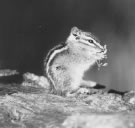 NATURE
HAPPENINGS - November 2002
NATURE
HAPPENINGS - November 2002
Where the Pronghorn
and Prairie Dogs Play
by Damian Fagan
 I
followed the set of tracks along a small desert wash in the Cisco
Desert. The long nails and overlapping print pattern were clearly
evident in the soft muddy sediments, giving away the signature of
its owner - an American badger. Of course, as I walked along the
wash I would often look up and search the bend before me - no need
to take one by surprise. The tracks went up a small embankment and
terminated where the badger had disappeared down into an oval-shaped
burrow.
I
followed the set of tracks along a small desert wash in the Cisco
Desert. The long nails and overlapping print pattern were clearly
evident in the soft muddy sediments, giving away the signature of
its owner - an American badger. Of course, as I walked along the
wash I would often look up and search the bend before me - no need
to take one by surprise. The tracks went up a small embankment and
terminated where the badger had disappeared down into an oval-shaped
burrow.
One set in, no tracks out. Though I waited a good hour with my camera
ready (plus long lens!) the badger never appeared. I thought of
the phrase “Let sleeping dogs lie” and figured that this
was applicable to badgers as well. No need to “badger”
this one.
 From
a distance a badger almost looks clownlike, with a large bulbous
nose, white-and-black striped face and dachshund-height, but this
comical appearance rapidly degenerates as a badger gets closer.
“Controlled fury” may be an anthropomorphic description,
but there is an intensity about these fearless predators that catches
one’s attention.
From
a distance a badger almost looks clownlike, with a large bulbous
nose, white-and-black striped face and dachshund-height, but this
comical appearance rapidly degenerates as a badger gets closer.
“Controlled fury” may be an anthropomorphic description,
but there is an intensity about these fearless predators that catches
one’s attention.
Though basically nocturnal, badgers may be active in the day, rumbling
across open plains or trotting along canyon bottoms. Designed to
slip into abandoned burrows or rapidly excavate one of their own,
badgers are built low to the ground with a flattish shape and a
wider-than-higher body. Their thick grizzly-gray coats make them
appear larger than they are.
And with front feet that are partially webbed - and have long, curved
claws - and hind feet with shovel-like claws, badgers are digging
machines. A badger can excavate a prairie dog burrow faster than
a man with a shovel. Bad news for some small rodent seeking shelter
in an underground burrow.
 Badgers
prey upon ground squirrels, mice, kangaroo rats, small rabbits,
and pocket gophers, as well as worms, birds, reptiles and carrion.
Badgers will even take rattlesnakes, unharmed by the venom as the
snake tries to strike through the badger’s thick, protective
coat. Adapted to tunneling after prey, hence the long and shovellike
claws, badgers have been known to lose an escaping rodent to an
opportunistic coyote, who patiently waits for an easy meal pf escaping
rodent.
Badgers
prey upon ground squirrels, mice, kangaroo rats, small rabbits,
and pocket gophers, as well as worms, birds, reptiles and carrion.
Badgers will even take rattlesnakes, unharmed by the venom as the
snake tries to strike through the badger’s thick, protective
coat. Adapted to tunneling after prey, hence the long and shovellike
claws, badgers have been known to lose an escaping rodent to an
opportunistic coyote, who patiently waits for an easy meal pf escaping
rodent.
Related to skunks and weasels, the American badger exudes (not sprays)
a shunklike musk. The musk may be a way this solitary predator marks
its territories against other male badgers or acts as a signal to
receptive female badgers who are entering estrous in late summer
or early autumn. This musky odor attracts other badgers through
olfactory senses, rather than through vocalizations like bird songs.
 One
aspect of badger mating that is interesting is that the fertilized
embryo is in a sort of suspended animation until midwinter. Sometime
from December to February, the egg will then implant into the uterine
wall and resume development. Though the female badger may be technically
pregnant for seven months, the embryo develops in less than seven
weeks.
One
aspect of badger mating that is interesting is that the fertilized
embryo is in a sort of suspended animation until midwinter. Sometime
from December to February, the egg will then implant into the uterine
wall and resume development. Though the female badger may be technically
pregnant for seven months, the embryo develops in less than seven
weeks.
A good place to look for badgers in November is where the pronghorn
and prairie dogs play. The Cisco Desert, Green River Desert or Hatch
Point are just a few locations to search for badgers. A good pair
of binoculars or a spotting scope might be helpful to scan the open
desert (plus to help you keep your distance), but also be on the
lookout for tracks or large craters that might reveal past activity
of this powerful desert creature.